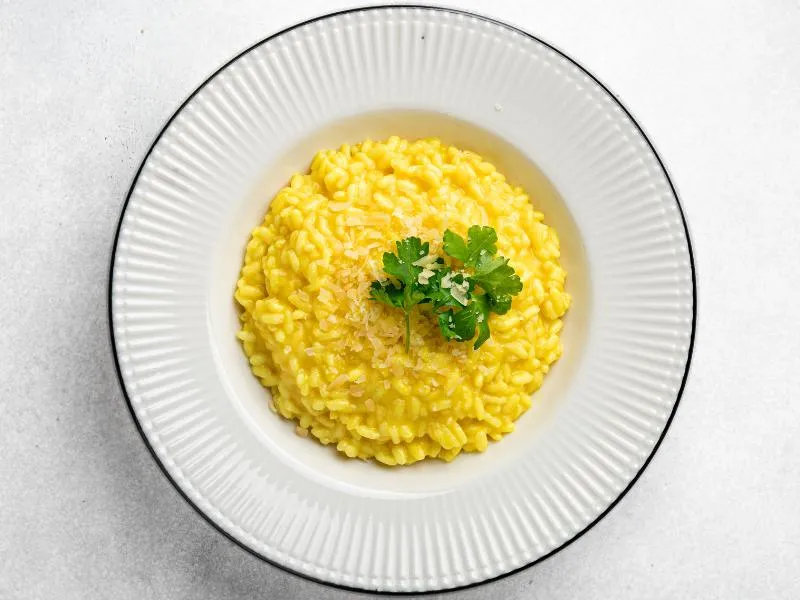Risotto alla Milanese
Creamy saffron-infused rice dish cooked with broth, butter, and Parmigiano-Reggiano cheese.
👉 View Authentic Recipe 👈
About This Dish
Risotto alla Milanese is the signature dish of Milan, the capital city of Lombardy in northern Italy. Dating back to the 16th century, this iconic dish is characterized by its distinctive golden color and rich flavor derived from saffron, the world’s most expensive spice. Legend connects its origin to a 1574 cathedral stained glass artist who added saffron to rice at a wedding feast, though historical evidence suggests the dish evolved from the region’s rice-growing tradition.
The dish exemplifies Milanese cuisine’s elegance and refinement, featuring just a few high-quality ingredients: short-grain rice (traditionally Carnaroli or Arborio), beef bone marrow, saffron, white wine, butter, and Parmigiano-Reggiano cheese. Its preparation showcases the classic risotto technique of gradually adding hot broth to rice while continuously stirring to develop the creamy consistency known as “all’onda” (wavelike).
Traditionally served as a first course before ossobuco (braised veal shanks) to create the classic pairing “ossobuco con risotto,” this dish represents the pinnacle of northern Italian cuisine. In Milan, it’s commonly featured at important family gatherings and celebrations, embodying the region’s culinary heritage and the historical wealth of the Lombardy capital.
🧑🍳 Analyzed by CucinaBot
Why This Dish Works
Risotto alla Milanese achieves its perfect texture through the slow release of starch from short-grain rice, creating a naturally creamy consistency without adding cream. The saffron not only contributes its distinctive color but also provides subtle earthy, honeyed notes that complement the richness of bone marrow and butter. The continuous stirring and gradual addition of hot broth ensure even cooking while developing the rice’s creamy exterior while maintaining a slight firmness (al dente) at the center of each grain.
Key Success Factors
- Rice Selection: Using proper high-starch, short-grain rice varieties (Carnaroli preferred, Arborio acceptable) that can withstand stirring without breaking
- Proper Toasting: Toasting the rice in fat (tostatura) until translucent but not browned seals the exterior and ensures proper starch release
- Saffron Timing: Adding pre-steeped saffron midway through cooking (not at the beginning or end) for optimal color distribution and flavor development
- Mantecatura: The final vigorous stirring of butter and cheese off the heat creates the signature silky, flowing texture
Common Pitfalls
Many non-authentic recipes compromise the dish by adding cream, onions, garlic, or herbs that mask the pure flavor of saffron. Another common mistake is using pre-packaged saffron powder instead of whole threads, resulting in a bitter taste and artificial color. Equally problematic is the tendency to overcook the rice, producing a gluey consistency rather than the ideal flowing, creamy texture where individual grains remain distinct.
How to Judge Authenticity
When reviewing recipes, look for these markers of authenticity:
- Uses bone marrow or at least starts with butter (never olive oil alone)
- Contains no garlic, herbs, or cream additives
- Specifies whole saffron threads steeped in hot liquid rather than powder
- Includes the critical final mantecatura step off the heat
- Creates a consistency that spreads slowly when plated (“all’onda” or wave-like)